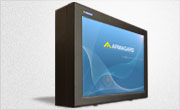Uploading Content to a Digital Signage Display
Posted by: Richard Williams | Posted on: | 0 Comments
So you have you screen erected, you have the display protected in an LCD enclosure and you have decided on what information you want the sign to display, the next step for any digital signage project is getting the information turned into engaging content and then uploading it onto the screen.
 The first step to generating content is deciding what exactly you want the content to achieve. For a retailer this may be a promotion or sales item you want to draw attention to, for a service provider, such as a school or college, it may be news of an event or a form of wayfinding, while a manufacturing or distribution business may want to communicate important information to staff and visitors.
The first step to generating content is deciding what exactly you want the content to achieve. For a retailer this may be a promotion or sales item you want to draw attention to, for a service provider, such as a school or college, it may be news of an event or a form of wayfinding, while a manufacturing or distribution business may want to communicate important information to staff and visitors.
The next step is to evaluate the sign’s position and location and how much time you have to get the message across. The amount of time people engage with a screen differs depending on location. Indoors signs may attract people’s attention for several seconds, while an outdoor digital sign has less time to engage people. Therefore, content for an outdoor digital sign needs to be simple and direct, while an indoor screen may offer a little more freedom to provide more detailed messaging.
While digital signage displays have the potential to display complicated moving imagery, wherever the sign is located, it is best to stick with simple, bold content, limiting the transitions and not going overboard with fancy graphics and effects. For a sophisticated digital signage campaign, it may be worth considering using a third party to generate content but for simple information, this can easily be done in-house. All sorts of content generation software is available, most of which is easy to use and readily available to download to most PCs.
Once you have generated the content, the next step is to get it to display on the screen. For this, some form of media player and content management software is required. These vary from simple devices that are designed to upload and schedule content to single screens by a USB cable, to more complicated and sophisticated devices and systems that can handle hundreds of messages and disseminate them to hundreds of screens through a networked system.
Basically, a media player works like a small PC and content is usually uploaded in standard video or image files such as JPG, GIF, PNG, TIFF, MPG, WMV, MPEG or AVI. Most content management platforms enable the displaying of multiple messages and scheduling of content for different times. Once the screen is displaying the content, everything should be tested to ensure messages are being displayed correctly.
Post shortlink:
Popular Products
LCD Enclosure
Need armor for your LCD/LED screen(s)? Outdoors or inside the versatile LCD enclosure protects against thieves, vandals & the weather. Installation idea: NFL stadiums.
Outdoor Digital Signage
Exclusive 46” outdoor screen protection. Dubbed the ‘Totem’, due to its distinct design, it repels damage threats, but attracts audiences. Installation idea: Drive-thru restaurants.
Portrait Flat Panel Enclosure
Safeguard your eye-level advertising display screen(s), indoors or outdoors. Completely customizable, add exciting features like touch screen technology. Installation idea: Restaurant frontages.
Indoor Digital Signage
Popular purchase for retail outlets! Great for ‘point of sale’ persuasion, boost your brand with static & motion advertising from a single unit! Installation idea: Mall of America.




